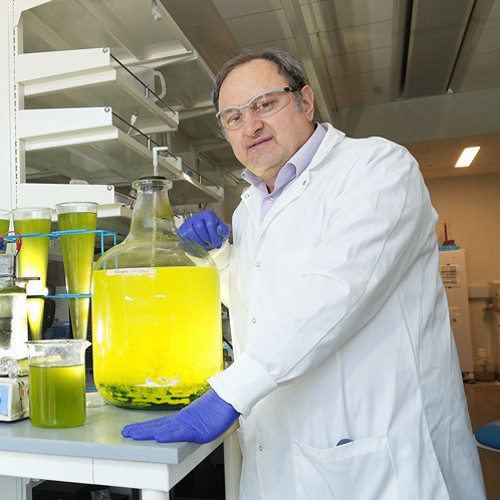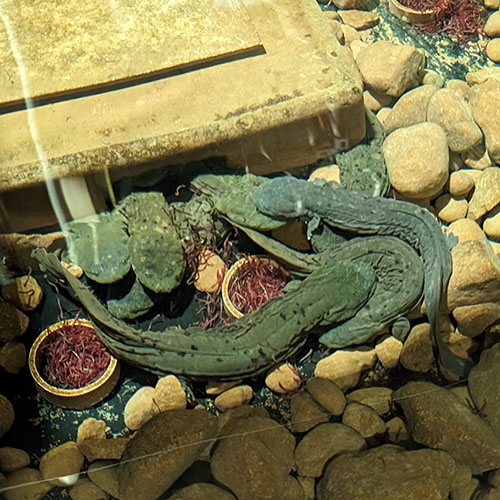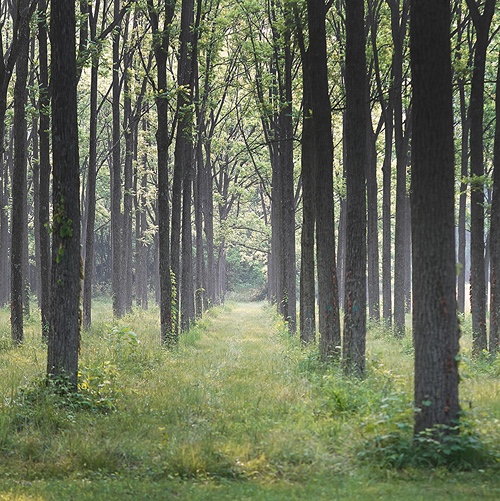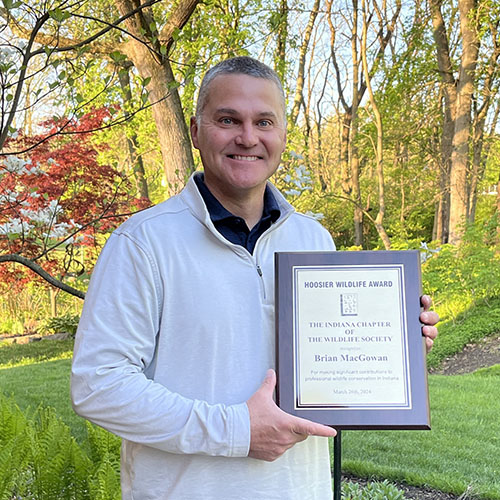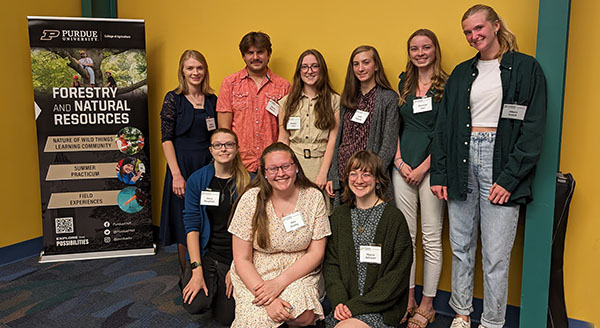“The uninhibited wildlife was absolutely crazy to see and it's absolutely gorgeous on the islands to boot,” sophomore ecology, evolution and environmental biology major Sierra Hunnicutt said of her August 2023 study abroad trip to Ecuador and the Galápagos. “Just imagine seeing sea lions, giant tortoises, blue-footed boobies, black tip sharks, marine iguanas, and so many sea turtles all in the span of a week!”
Hunnicutt was one of 32 individuals who spent August 7-15 exploring the “Environment and Culture in the Galápagos” on a study abroad trip led by Drs. Elizabeth Flaherty and Kristen Bellisario and Purdue Forestry and Natural Resources diversity administrator Megan Gunn.
The course aims to introduce students to the unique environments and the culture of the Galápagos Islands and Ecuador, while integrating ecological topics including biodiversity, adaptation and evolution, biogeography, endemicism, and conservation biology. Students learned about the history of the islands and explored diverse ecosystems in both marine and terrestrial environments. They also saw wildlife species ranging from giant tortoises to marine iguanas, frigatebirds, sea lions, whales, Galápagos penguins, sea turtles, Darwin’s finches, sharks, and many more. Students also learned about human impacts on the islands resulting from climate change, invasive species, and tourism.
Prior to the trip, students met every other week during the spring semester to prepare to travel internationally, discuss topics of interest and make presentations about their own research on the various fish, coral, aquatic species, mammals, birds and sounds they might encounter.
“The study abroad trip to the Galápagos and Ecuador was an incredible experience,” senior wildlife major Anne Talbot said. “I had a great time and got to meet a lot of new people. Seeing the wildlife there was an unforgettable experience. It was cool to see Darwin's famous finches in person. They were one of the things I was most excited to see. To see the finches, tortoises, and marine iguanas we have heard so much about in our classes was an experience like no other. The views of the natural landscape on the islands and the mainland were also extraordinary as was the architecture we saw in Quito.”
The trip took students to Quito and to the Baltra, Santa Cruz and San Cristóbal Islands in Ecuador.
In Quito, visits to Independence Plaza, Government Palace (the Quito presidential palace), Santo Domingo Monastery and the Intiñan Museum, located at the Equatorial Line also provided a highlight.
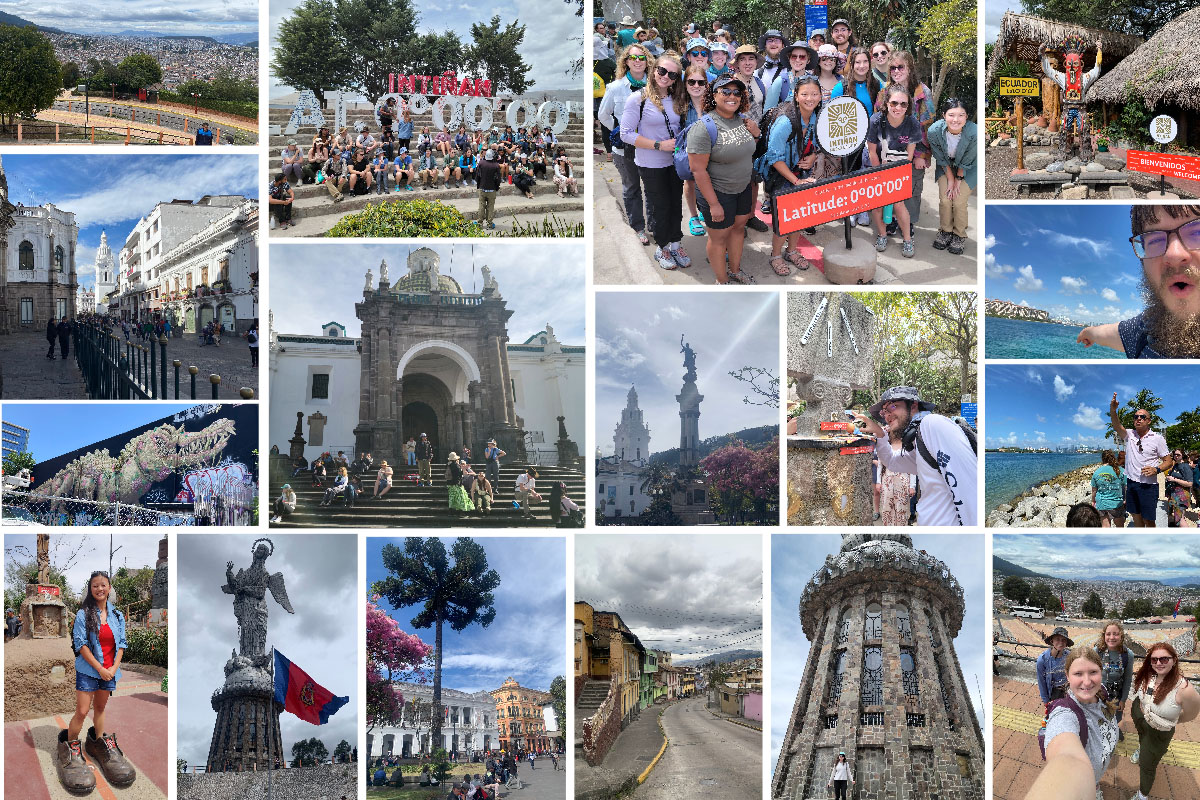 A collage of images from Quito, Ecuador. Row 1: A view of Quito from above; a sign at Intiñan Museum noting zero degrees latitude; the study abroad group at the equator; a welcome sign and statue greet visitors to the equator at Intiñan Museum. Row 2: Calle Garcia Moreno; graffiti by @saturnoart; Catedral Metropolitana de Quito; Plaza de la Independencia; the Four Seasons Index Stone at zero latitude; a look at the Miami shoreline with Nate Pingel. Row 3: Anne Talbot with one foot on each side of the equator; a statue of the Virgin of the Panecillo; the Plaza Grande in Quito; a street in Quito; the base of the Virgin of Panecillo monument; members of the study abroad group with Quito in the background.
A collage of images from Quito, Ecuador. Row 1: A view of Quito from above; a sign at Intiñan Museum noting zero degrees latitude; the study abroad group at the equator; a welcome sign and statue greet visitors to the equator at Intiñan Museum. Row 2: Calle Garcia Moreno; graffiti by @saturnoart; Catedral Metropolitana de Quito; Plaza de la Independencia; the Four Seasons Index Stone at zero latitude; a look at the Miami shoreline with Nate Pingel. Row 3: Anne Talbot with one foot on each side of the equator; a statue of the Virgin of the Panecillo; the Plaza Grande in Quito; a street in Quito; the base of the Virgin of Panecillo monument; members of the study abroad group with Quito in the background. 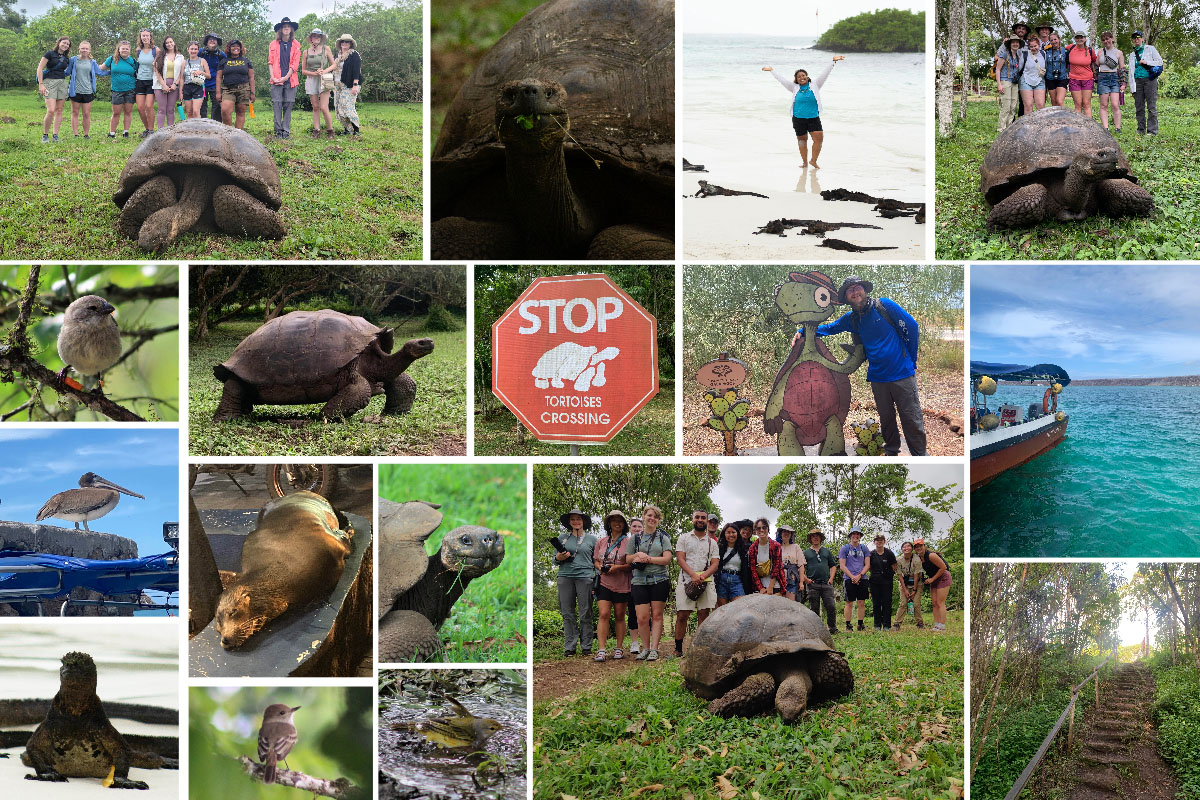 A collage of images from Santa Cruz Island. Row 1: Members of the study abroad group with a Galapagos tortoise; a close-up a tortoise eating; Megan Gunn on a beach with marine iguanas; members of the study abroad group with a Galapagos tortoise. Row 2: A finch; a Galapagos tortoise walking; a stop tortoise crossing sign; Nate Pingel with turtle signs at the Aeropuerto Ecologico Galapagos; a look at the boat and water. Row 3: A brown pelican; a sea lion resting; a Galapagos tortoise eating. Row 4: a Marine iguana; a Galapagos flycatcher; a Yellow Warbler; members of the study abroad group with a Galapagos tortoise; stairs through the woods.
A collage of images from Santa Cruz Island. Row 1: Members of the study abroad group with a Galapagos tortoise; a close-up a tortoise eating; Megan Gunn on a beach with marine iguanas; members of the study abroad group with a Galapagos tortoise. Row 2: A finch; a Galapagos tortoise walking; a stop tortoise crossing sign; Nate Pingel with turtle signs at the Aeropuerto Ecologico Galapagos; a look at the boat and water. Row 3: A brown pelican; a sea lion resting; a Galapagos tortoise eating. Row 4: a Marine iguana; a Galapagos flycatcher; a Yellow Warbler; members of the study abroad group with a Galapagos tortoise; stairs through the woods. Day 3 involved a trip to Tortuga Bay to go swimming, which introduced students to the natural habitat of blue-footed boobies, black-tipped sharks, puffer fish, herons and other aquatic animals. The day wrapped up with a trip to the Charles Darwin Research Station to learn about captive breeding efforts for the various species of Galápagos tortoises.
 A collage of images from Tortuga Bay. Row 1: A beach full of marine iguanas; a street through the city; a view of the bay; Nate Pingel made friends with a statue of Charles Darwin; members of the study abroad group with a statue of a Galapagos tortoise. Row 2: A marine iguana; a Yellow Warbler; Galapagos tortoises; a sunset view of a cobblestone street; an art exhibit made of plastic trash collected from the beach; the sign for the Centro de Crianza de Tortugas Terrestres. Row 3: Sierra Hunnicutt points at a blue-footed booby on the shoreline; a lava lizard; a Sally lightfoot crab; a marine iguana; a view of a local market; the sign for Parque Nacional Galapagos. Row 4: A blue-footed booby; a selfie of the study abroad group; a brown pelican; fruit at a local market; a model of a Galapagos tortoise; members of the study abroad group at the beach.
A collage of images from Tortuga Bay. Row 1: A beach full of marine iguanas; a street through the city; a view of the bay; Nate Pingel made friends with a statue of Charles Darwin; members of the study abroad group with a statue of a Galapagos tortoise. Row 2: A marine iguana; a Yellow Warbler; Galapagos tortoises; a sunset view of a cobblestone street; an art exhibit made of plastic trash collected from the beach; the sign for the Centro de Crianza de Tortugas Terrestres. Row 3: Sierra Hunnicutt points at a blue-footed booby on the shoreline; a lava lizard; a Sally lightfoot crab; a marine iguana; a view of a local market; the sign for Parque Nacional Galapagos. Row 4: A blue-footed booby; a selfie of the study abroad group; a brown pelican; fruit at a local market; a model of a Galapagos tortoise; members of the study abroad group at the beach. On Day 4, the group took an early morning two-hour ferry ride to San Cristóbal Island. Following time to explore the pier and view dozens of sea lions napping, the students visited the Las Tijeretas Interpretive Center and learned about the human history on the Galápagos Islands before snorkeling in Darwin Bay with sea lions, sea turtles and fish.
“One of my favorite memories from the Galápagos study abroad trip was watching the sea lions from shore,” said Allison Schimpf, a junior animal science major with a concentration in pre-veterinary medicine and minors in biological sciences and horticulture. “They were very social towards each other and made unique sounds. Many of the other big moments I have taken away from this trip center around animals. Being able to see the Giant Galápagos Tortoise up close was amazing. Along with that, we were able to watch sea turtles play in the water right off the beach. We witnessed schools of various fish while snorkeling and even saw shark fins in the distance during a boat ride. I loved the diversity offered on this trip and I am very glad I chose to participate in this study abroad.”
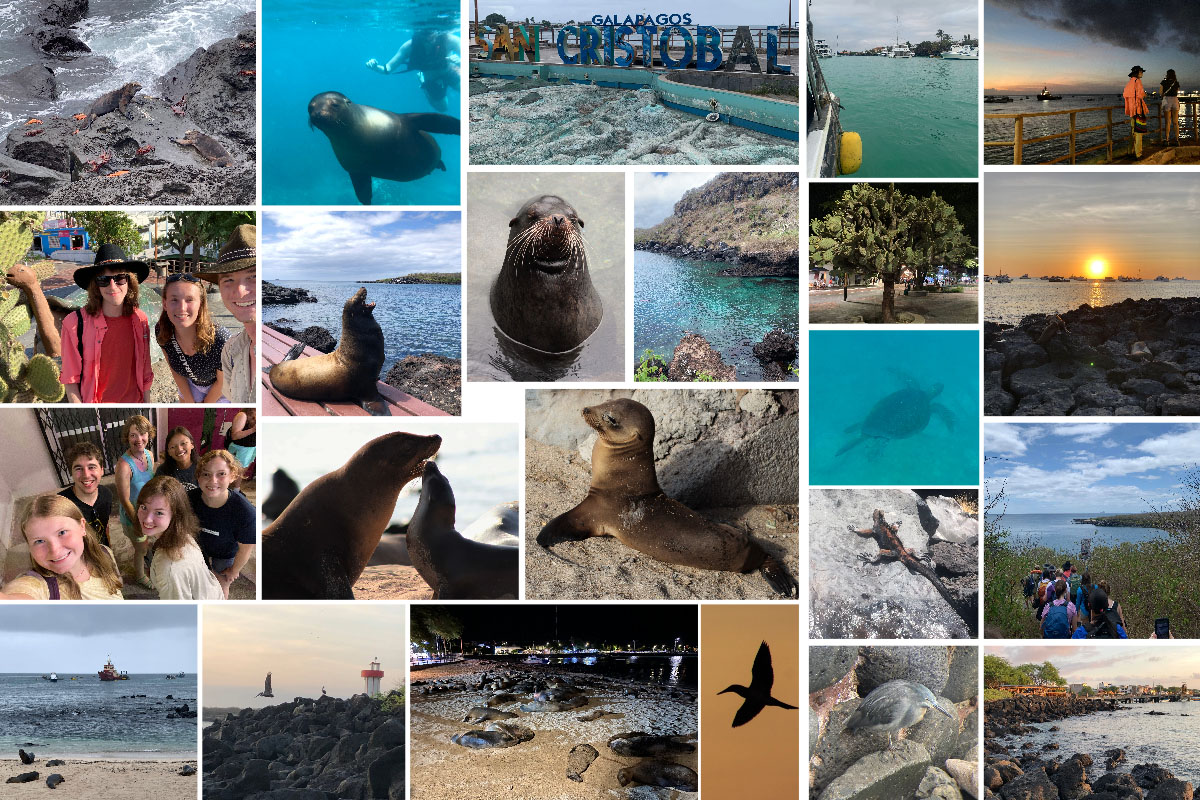 A collage of images from San Cristóbal Island. Row 1: crabs and marine iguanas on lava rocks; a sea lion swimming in front of an individual snorkeling; the San Cristóbal island sign; green-tinged water with boats in the background; a sunset at the harbor. Row 2: Members of the study abroad group with a cactus and a tortoise statue; a sea lion barking on the dock with crystal blue water in the background; a close-up of a sea lion with prominent whiskers; a bay of rocks and blue-green water; an Opuntia cactus; a sunset over the bay. Row 3: A selfie of a group of students; Two sea lions nearly touching noses; a small sea lion stretched out on the sand; a sea turtle swimming; a marine iguana suns itself on a rock; students approach a waterbody with a blue cloud-filled sky in the distance. Row 4: Sea lions on the shore with a boat approaching; a pelican flies over rocks next to a lighthouse; several sea lions rest on the sand in front of a night-time bay scene; a blue-footed booby flies across an orange sky; a lava heron; a view of the island with rocks in the foreground, a bay and the city in the background.
A collage of images from San Cristóbal Island. Row 1: crabs and marine iguanas on lava rocks; a sea lion swimming in front of an individual snorkeling; the San Cristóbal island sign; green-tinged water with boats in the background; a sunset at the harbor. Row 2: Members of the study abroad group with a cactus and a tortoise statue; a sea lion barking on the dock with crystal blue water in the background; a close-up of a sea lion with prominent whiskers; a bay of rocks and blue-green water; an Opuntia cactus; a sunset over the bay. Row 3: A selfie of a group of students; Two sea lions nearly touching noses; a small sea lion stretched out on the sand; a sea turtle swimming; a marine iguana suns itself on a rock; students approach a waterbody with a blue cloud-filled sky in the distance. Row 4: Sea lions on the shore with a boat approaching; a pelican flies over rocks next to a lighthouse; several sea lions rest on the sand in front of a night-time bay scene; a blue-footed booby flies across an orange sky; a lava heron; a view of the island with rocks in the foreground, a bay and the city in the background. On Day 6, more time for snorkeling in the morning brought additional encounters with sea lions, sea turtles and marine iguanas at La Loberîa, which is named for the large number of sea lions resting on the rocks and sand of its shoreline.
“My favorite memory from my study abroad to the Galápagos Islands was snorkeling at Darwin’s Beach,” senior wildlife major Katie Arnold shared. “As a wildlife major, being that close to wildlife was incredible. Having the baby sea lions swim around us was one of the coolest things I have ever experienced! It was also amazing to swim alongside the sea turtles as I have never seen one so close up in the wild. I also enjoyed seeing all of the different land animals and one of my favorite birds, the blue-footed booby. I’m so glad I decided to apply for this study abroad!”
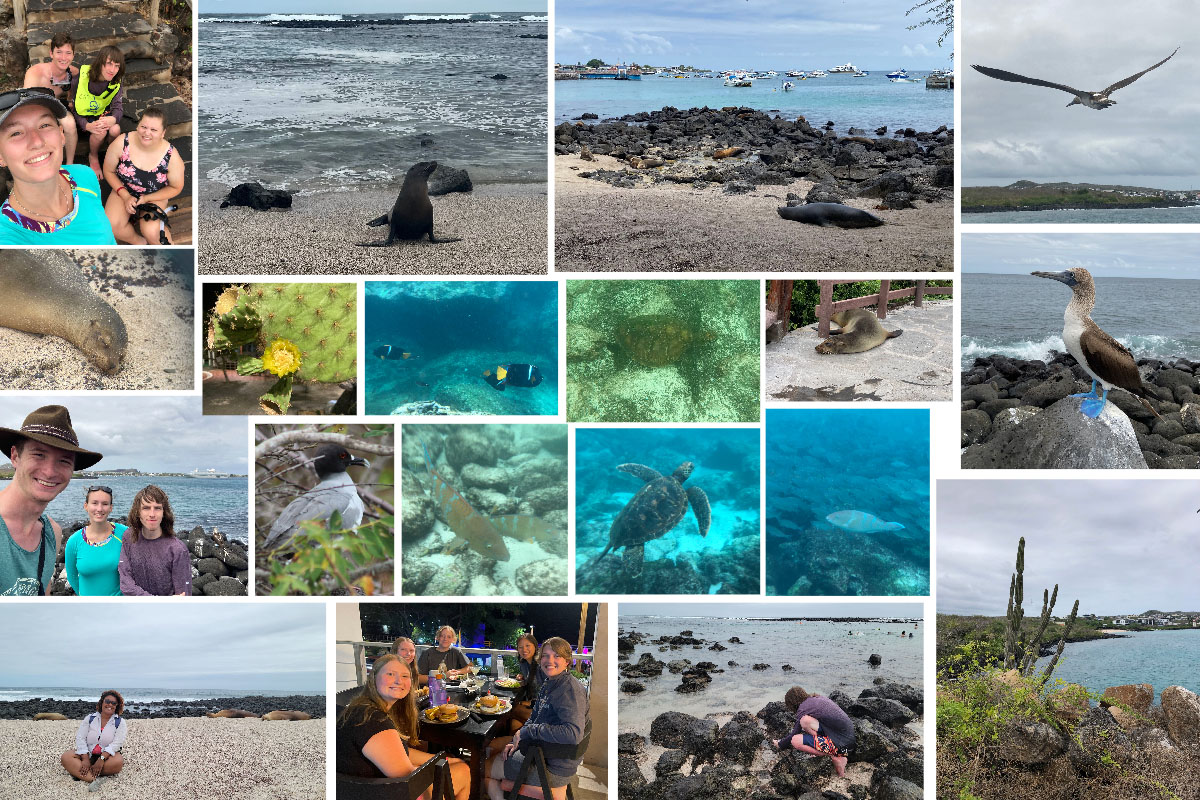 A collage of images from La Loberîa. Row 1: Members of the study abroad group sit on rock steps; a sea lions walks on the sand in front of foamy water; sea lions rest on the sand with a bay full of ships in the background; a blue-footed booby flies in a cloudy sky. Row 2: A sea lion sleeps in the sand; a prickly pear cactus (Opuntia species) with yellow flower; a king angelfish; a sea turtle; a sea lion resting on a stone walking path; a blue-footed booby stands atop a rock with a wave crashing in the background. Row 3: Members of the study abroad group in front of the bay with a cruise ship in the background; a swallow-tailed gull; a pair of blue-barred parrotfish; a sea turtle swimming; a parrotfish swims in front of a school of fish. Row 4: Megan Gunn sits on a beach with sea lions to her left and right; a group of students eats dinner; a student looks closely at the rocks in the bay; a cactus and rocks frame the bay.
A collage of images from La Loberîa. Row 1: Members of the study abroad group sit on rock steps; a sea lions walks on the sand in front of foamy water; sea lions rest on the sand with a bay full of ships in the background; a blue-footed booby flies in a cloudy sky. Row 2: A sea lion sleeps in the sand; a prickly pear cactus (Opuntia species) with yellow flower; a king angelfish; a sea turtle; a sea lion resting on a stone walking path; a blue-footed booby stands atop a rock with a wave crashing in the background. Row 3: Members of the study abroad group in front of the bay with a cruise ship in the background; a swallow-tailed gull; a pair of blue-barred parrotfish; a sea turtle swimming; a parrotfish swims in front of a school of fish. Row 4: Megan Gunn sits on a beach with sea lions to her left and right; a group of students eats dinner; a student looks closely at the rocks in the bay; a cactus and rocks frame the bay. On Day 7, students had the morning available to do more snorkeling and swimming on San Cristóbal before flying back to Quito in the afternoon.
For Talbot, snorkeling provided up-close-and-personal encounters with both sea turtles and sea lions.
“The most memorable part of the trip was snorkeling,” Talbot said. “The sea lions and the sea turtles swam right next to us. The sea lions swam in the water with amazing speed and agility and would do flips and jumps in front of us like they were showing off. They were incredibly playful and curious and would swim so close they were almost touching us. Sometimes they actually did. I had one lightly tug on a strap hanging off of my life jacket. It was quite a surprise to turn around and see a sea lion staring at me from not even a foot away. I am incredibly grateful that I had the opportunity to go on this trip. It was a trip of a lifetime!”
The interactivity of the sea lions also provided a highlight for Hunnicutt.
“The absolute most memorable moment from the trip was snorkeling with sea lions. They’re so playful and unafraid that they would swim right up to you and do a barrel roll, encouraging you to do the same,” Hunnicutt said, although she admitted the ‘funny but special’ blue-footed booby was her favorite species on the trip.
Marley White, a sophomore natural resources and environmental science and political science double major, noted the variety of species the group saw on the trip, but said the Galápagos sea lions were her favorite.
“I would say the most memorable part of the trip to the Galápagos was getting to see such a diversity of wildlife thrive in their natural habitats while still coexisting with humans,” White said. “Snorkeling and having sea lions swim right past me, completely comfortable with my presence, was an amazing experience."
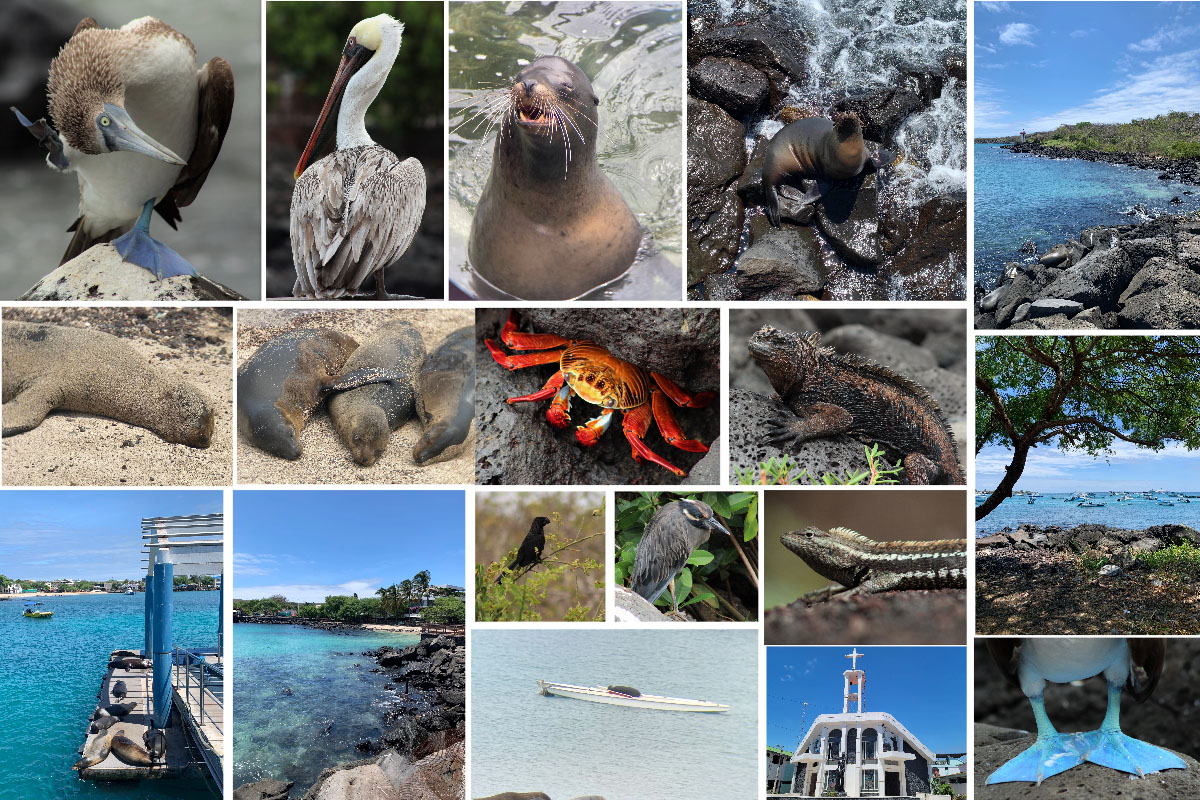 A collage of images from San Cristóbal. Row 1: A blue-footed booby itches its head; a brown pelican; a sea lion smiles; a sea lion poses on the rocks with waves foaming around it; waves crash lightly against rocks of a brightly blue colored bay. Row 2: a sand covered sea lion sleeps; a group of three sea lions rest together with their flippers touching; a Sally lightfoot crab; a marine iguana. Row 3: A smooth-billed Ani; a yellow-crowned night heron; a lava lizard; a tree leans across the landscape as boats float in the nearby bay. Row 4: sea lions rest on the dock; a rocky shoreline; a sea lion rests on a boat floating in the middle of a bay; the Catedral Inmaculada Concepcion; a close-up of the feet of a blue-footed booby.
A collage of images from San Cristóbal. Row 1: A blue-footed booby itches its head; a brown pelican; a sea lion smiles; a sea lion poses on the rocks with waves foaming around it; waves crash lightly against rocks of a brightly blue colored bay. Row 2: a sand covered sea lion sleeps; a group of three sea lions rest together with their flippers touching; a Sally lightfoot crab; a marine iguana. Row 3: A smooth-billed Ani; a yellow-crowned night heron; a lava lizard; a tree leans across the landscape as boats float in the nearby bay. Row 4: sea lions rest on the dock; a rocky shoreline; a sea lion rests on a boat floating in the middle of a bay; the Catedral Inmaculada Concepcion; a close-up of the feet of a blue-footed booby. The final stop on the trip before returning home was a visit to the city of Otavalo in the Andean highlands outside of Quito. This city is known for its woven textiles and the group was able to visit a large market in the center of the city.
The Galápagos study abroad trip was last offered in 2019.
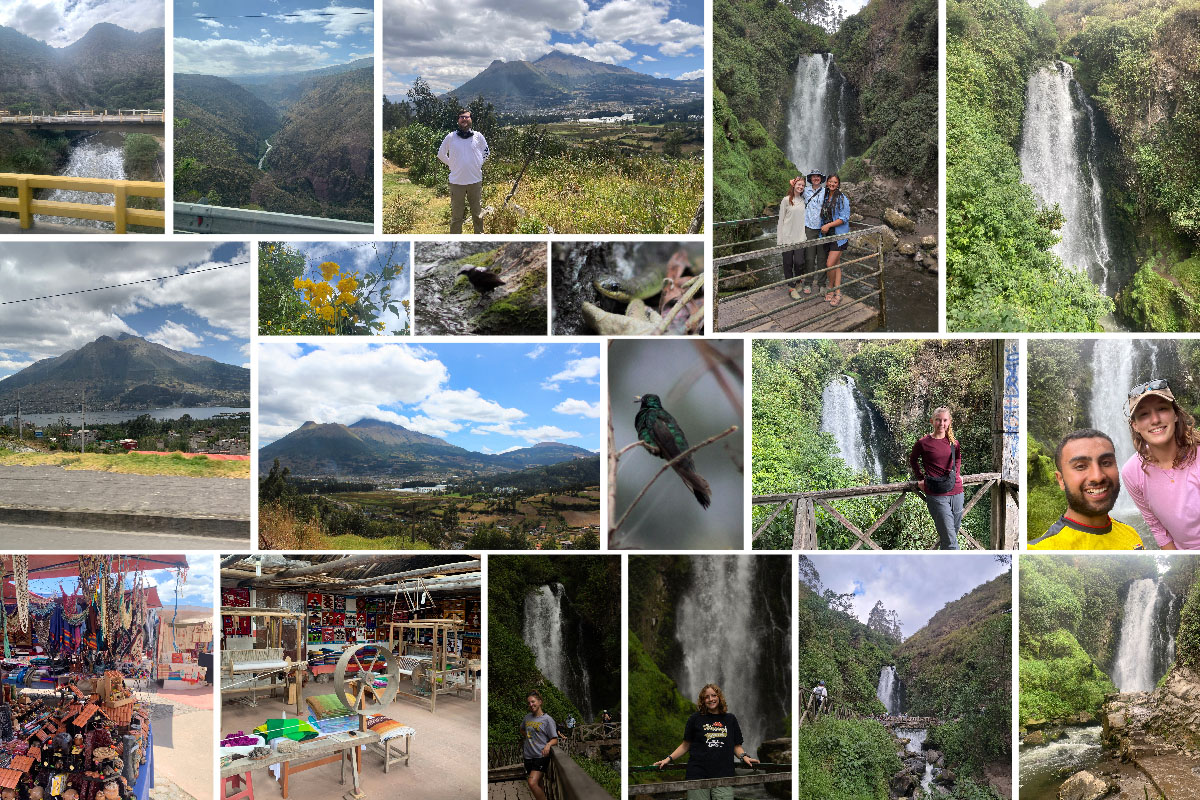 A collage of images from the Andean Highlands. Row 1: water passes under a bridge; a river runs through a mountain-side landscape; Nate Pingel stands with the mountains in the background; Ruby Sanders and Anne Talbot stand with another student in front of a waterfall; a waterfall near Otavalo. Row 2: A blue sky with bright white clouds float over a mountain view; yellow bell flowers (Tecoma stans); a white-capped dipper; a snake slithers past a rock. Row 3: A landscape view of mountains; a Sparkling Violetear; Allison Schimpf stands in front of the water fall; Audrey Heckel poses in front of the waterfall with another student. Row 4: A market in Otavalo; a textile market in Otavalo; students stand in front of the waterfall; a zoomed-out view of the waterfall and surrounding area; the base of the waterfall empties into the stream below.
A collage of images from the Andean Highlands. Row 1: water passes under a bridge; a river runs through a mountain-side landscape; Nate Pingel stands with the mountains in the background; Ruby Sanders and Anne Talbot stand with another student in front of a waterfall; a waterfall near Otavalo. Row 2: A blue sky with bright white clouds float over a mountain view; yellow bell flowers (Tecoma stans); a white-capped dipper; a snake slithers past a rock. Row 3: A landscape view of mountains; a Sparkling Violetear; Allison Schimpf stands in front of the water fall; Audrey Heckel poses in front of the waterfall with another student. Row 4: A market in Otavalo; a textile market in Otavalo; students stand in front of the waterfall; a zoomed-out view of the waterfall and surrounding area; the base of the waterfall empties into the stream below. 